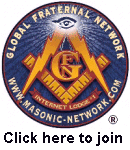
The GFN Treasure Chest Archives
www.masonic-network.com
"Where Master Masons Communicate"

 |
The GFN Treasure Chest Archiveswww.masonic-network.com |
 |
The explanation continues: “Their philosophers…couched their systems of learning…under signs and hieroglyphical figures, which were communicated to their chief priests or Magi alone, who were bound by solemn oath to conceal them.” (William Preston. Illustrations of Masonry. 1804. Reprint: Wellingborough, 1986. p.42) This does not reveal the full story. There are residues from ancient Egypt in Freemasonry, carried through the millennia by the mystical philosophy attributed to the legendary Hermes Trismegistus.
The early 15th century ‘Charge’, the Cooke manuscript, tells of “Hermes the philosopher” who, along with Pythagoras, restored knowledge to the world after the Flood, having found it written on two great pillars. (Matthew Cooke. The History and Articles of Masonry. London, 1861.pp 46-49) Hermes Trismegistus is the Greek rendering of the Egyptian god Thoth: god of wisdom, knowledge, secrets, magic and writing.
One of the great symbols of Hermetic thought is the hexalpha of two interlocking triangles. It represents the dynamic interweaving of heaven and earth, the visible and invisible. This symbol is prominent on the Royal Arch jewel. Below, on a scroll, is a Latin text which translates as: “Nothing wanting but the Key.” Does this refer to something which has been lost and must be found? If so, it brings us back to Thoth-Hermes, the god of the Word.
The Greek Domination of Egypt
The Greek armies, led by Alexander the Great, invaded and defeated Egypt in 331 BC. After Alexander’s death, one of his generals, Ptolemy, ruled as king, founding a dynasty which ruled for over 300 years, finally ending with the death of Cleopatra in 30 BC. During this era, Greek culture dominated; Egyptians feared that theirs would be lost. Accordingly, Egyptians trained in the Greek culture began recording and revealing their wisdom, so long concealed in the temples. Out of this world, during the first and second centuries AD, came the Hermetica: a collection of texts supposedly written by Hermes Trismegistus. But their true origin was recorded. The Syrian Iamblichus, writing in the early fourth century AD, revealed that the books circulating under the name Hermes, although written in the Greek philosophical style, contained true Hermetic doctrines. They had been translated from the Egyptian language, he said, by those educated in the Greek philosophical tradition. (Iamblichus. On the Mysteries. VIII.4. Trans. Thomas Taylor, Chthonios reprint, 1989.)
The Temple Mysteries
It is known that within the sacred chambers and halls of their temples, the Egyptian priests practised a technique of mystical initiation. They fostered, through stillness and silence, a deliberate incubation, a journey to the gates of death where questions might be put to the gods: a dialogue with the gods through visions and dreams.
It is clear that some of the ancient texts, rituals and spells, apparently aimed at the dead, were used to serve the living. For example, the oldest section of the Egyptian Book of the Dead is called “The Book of Coming Forth by Day”. A more mystical rendering would be: “Instructions for coming forth into the Light”. These are instructions for an initiation, not a funeral.
Shepherd and Son of God
The first of the philosophical books of Hermes is called, in its original Greek: Poimandres. This is a very revealing name. It means “Shepherd” and for many years scholars took this name to be the explanation: Hermes shepherding those on the way to wisdom. But there is more to it than this; it is a play on words. Poimandres derives from the ancient Egyptian P-eime nte-re which means “The Understanding, or Intelligence, of Re”, the god of whom the sun is the visible presence. (Peter Kingsley. Poimandres: the etymology of the name and the origins of the Hermetica in the Journal of the Warburg and Courtauld Institutes, 56.1993, pp4-8.) Re was Lord of the Universe, the supreme god – and Thoth was his son, his representative. As a result, it is now accepted that the books of Hermes reveal the inner secrets of the Egyptian temples. In particular, those concerning initiation. The Poimandres states bluntly to the aspiring initiate: “Now fix your thought upon the Light and learn to know it.” (Corpus Hermeticum, Book I).
Freemasonry brings men into a more moral and more socially responsible way of life. But it does more than this. Masonic rituals gently, but methodically, guide and initiate each man through the degrees until, symbolically, the limits of mortality are brought to the forefront of his attention. Once there, he is confronted with the question of who he really is, and he is asked to fix his thoughts upon the glimmering ray of Light from above. This symbolic instruction is almost identical to the statement in the Poimandres. We have in Freemasonry, I believe, a distant, but actual, echo of those ancient mysteries: an echo of ancient Egypt.
Michael Baigent is a Freemason,